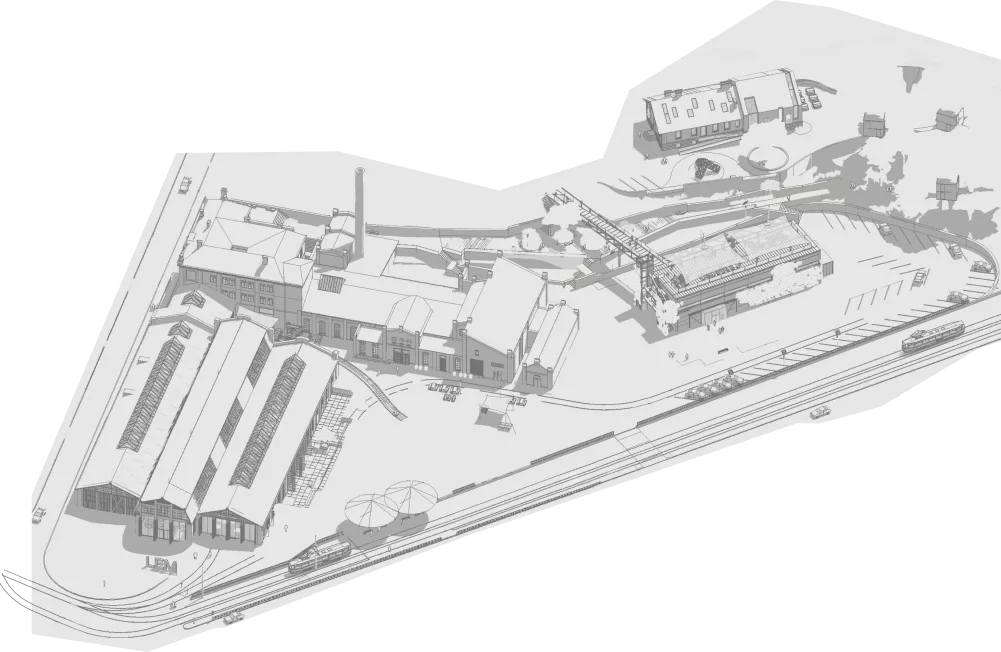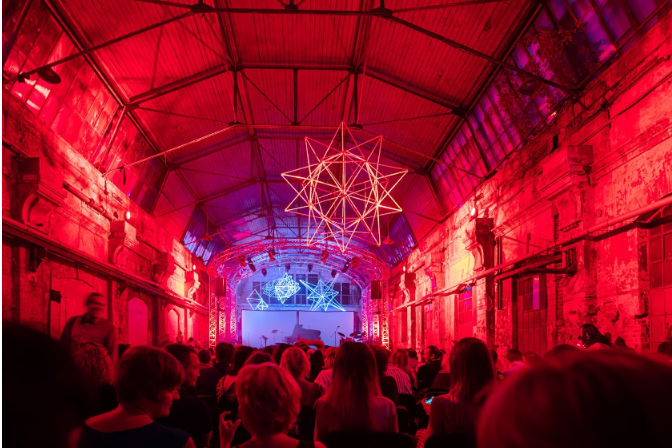In the heart of Lviv, Ukraine, an old tram depot at the intersection of Sakharov and Vitovsky streets is undergoing a remarkable transformation. Inspired by the writings of Richard Florida on Creative Class and Creative Cities, LEM Station aims to foster the development of business, social, and cultural initiatives. Its co-founders, Mark Zarkhin, Taras Kytsmey, Dmytro Kosaryev, and Oleh Matsekh, envisioned a space that serves as a point of intersection and self-fulfilment for various creative professionals.
LEM Station's journey began in 2014, following Ukraine's Revolution of Dignity. The founders, driven by a new vision for Lviv as a creative city, selected the historic tram depot for its unique architectural charm and strategic location. Since its inception, LEM Station has hosted over 600 events, providing a platform for creatives to showcase their work and engage with the community. Despite the disruptions caused by the Russian invasion, the hub has adapted by becoming a volunteer headquarters, supporting military and civilian efforts. This interview delves into the motivations, challenges, and future plans of LEM Station, offering a glimpse into how this creative hub is navigating through turbulent times.
Gregory Zarkhin, Project Manager, talked to us about how LEM Station managed to support the creative community while contributing aid to the military and the local community.
 Q: Why did you choose to base your hub in this area?
Q: Why did you choose to base your hub in this area?
A: This central part of the city has historic late 19th-century architecture built by the Austrian Empire, which had been abandoned and unused. Its unique architecture fits well with our creative concept. The location, right at the site of the city's first electric station, adds a futuristic vibe. It's also close to three universities and a large student accommodation village, making it an ideal spot. The area is well-connected with tram stations, and the building's peculiar architecture is integrated into our interior design.
Q: What did you manage to rebuild in your territory? What's the current situation after the Russian invasion?
A: Before the invasion, we were an acceleration hub for young creatives. After the war started, we became a volunteer headquarters, hosting live music events in bomb shelters to raise donations for the military. Our community, including many famous artists, helped paint and decorate over a hundred military and civilian vehicles. We also organized cultural events and exhibitions using VR technology to educate civilians about weapons and self-protection. Lviv, being the largest city in Western Ukraine and relatively safer, became a hub for military equipment and Western NGOs. Despite the challenges, we stabilized the internet connection and ensured businesses could operate, contributing to the economy.
Q: How do you envision the future?
A: We aim to complete construction and launch the first phase this year. We've finished the shelling core work and the interior design on paper, and we're now implementing it. We're also finalizing the selection of operators for shops and schools inside the hub. Despite the war, we have strong community support and stakeholders backing us. We plan to help the local council with transportation solutions and invite experts for further improvements. We'll soon have a bicycle rental and a power supply station on our premises. We're committed to finishing construction, launching all phases, and continuing to support the army. Operating normally, paying workers, and contributing to the economy are our priorities, even as we remain alert to potential challenges.
--
"Our inspiration partly comes from Stanisław Lem. At the "The Futurological Congress" he envisions the future through a lens of irony and scepticism"--Gregory Zharkin
--
We also intend to expand our social impact by collaborating on various projects that benefit the local community. For example, we're developing educational programs and workshops for students and professionals, aiming to foster innovation and creativity. Our partnerships with local businesses and international organizations will further strengthen our initiatives. Moreover, we're investing in sustainable practices to ensure that our hub not only thrives but also contributes to the city's environmental goals. This includes implementing green technologies and promoting eco-friendly transportation options. We're optimistic about the future and believe that our efforts will help revitalize the area, making it a vibrant centre for creativity, education, and community engagement. Despite the uncertainties, we remain dedicated to our mission and are confident that our hub will play a crucial role in the city's recovery and growth.
Becoming Stronger During Hard Times - Creating Opportunities
LEM Station's first methodology is one of adaptability. Gregory Zharkin emphasizes, "We are always adaptive. As we realize now during these hard times, we have learned to respond quickly; our connections and network skills are responsible for us being this way." Despite the ongoing challenges in Ukraine, LEM Station continues to support its community. Zharkin notes that once the war ends, they plan to research their adaptive strategies and develop a methodology for facing similar crises in the future. He adds, "Regardless of circumstances, we can teach others about the public and private partnerships, as part of the revitalization in difficult conditions to reach their goals. This is quite a unique expertise that we have." After establishing their first operational base, LEM Station intends to analyze their experiences and share their insights with others.
LEM Station is dedicated to fostering a win-win strategy with its network. "We are giving our space to creatives and makers and we also give them the opportunity to work for us and to use our premises," says Zharkin. For example, old windows and doors from the depot are given to makers for renovation. Scientists on the premises transform elements found in the warehouse garbage into artistic works, and art academy professors create sculptures, including a bust of Stanisław Lem, gifted out of gratitude. Zharkin highlights, "We build strong bonds with those creatives by giving them opportunities but also getting a lot of love and work in return. This is the basis of how we want to operate later." LEM Station always consults the art community for advice and expertise when planning the use of its premises. However, the Russian invasion has posed significant challenges, as many workers, including some top management, have been drafted. Zharkin points out, "We have to adjust since some of them are working while being on the frontline."
--
"We build strong bonds with those creatives by giving them opportunities but also getting a lot of love and work in return" --Gregory Zharkin
--

The Hub's History
In 2014, following the "Revolution of Dignity", there was a collective sense of inspiration and motivation to bring about positive change within communities across Ukraine. Six entrepreneurs, who were involved in drafting a new developmental concept for the city of Lviv, spearheaded this vision. The previous strategy, which had successfully transformed Lviv into the most touristic city in the country, was set to be replaced with a new one. This new strategy, aimed to transform Lviv into a creative city, drawing inspiration from Richard Florida's writings on the Creative Class and Creative Cities.
By 2015, the city council had accepted and disseminated the new strategy. Since then, two creative hubs have been completed, with six more in the pipeline. The entrepreneurs chose a historic location for the hub: an old tram depot built at the end of the 19th century. The site included an administrative building originally purposed for tram depot and electric station operators, and a compressor station intended to support Lviv’s potential metro system. These three elements collectively span 8,000 square meters, forming the core of our creative hub.
Due to the war, renovation efforts were postponed for about a year. "Despite this, over 600 events have already taken place in our space. Our first event was held in 2016, in a building that was then a neglected warehouse filled with random objects. We had just two months to prepare for what would become the largest classical music festival in the country over the next five years" says Gregory Zarkhin.
--
This new strategy, aimed to transform Lviv into a creative city, drawing inspiration from Richard Florida's writings on the Creative Class and Creative Cities.
--
This transformation marked the beginning of the hub’s evolution. It now represents a unique collaboration between the private sector and the public sector, as they are renting the space for 50 years. "Our inspiration partly comes from Stanisław Lem, a Polish science fiction writer known for his sharp mind and self-ironic perspective. His book, "The Futurological Congress," envisions the future through a lens of irony and scepticism, which greatly influenced our conceptual and directional development" he explains.
The hub also includes a working electric station, which proved invaluable during the winter when we faced electricity shortages. This station not only provided power for us but also supported the surrounding neighbourhood. Plans for a science museum are in place, though it currently serves as a retro car exhibition. Renovation and development have been delayed due to the war, yet our community remains active and resilient.
"Since we have not yet fully commissioned the space, we offer it for free to various event organizers and theatres, encouraging volunteer donations. This approach helps us build a strong community of stakeholders who support our vision and contribute to the hub's ongoing development" adds Gregory.
--
Originally published at https://creativehubs.net/. Written by Myriam Patrou









 Q: Why did you choose to base your hub in this area?
Q: Why did you choose to base your hub in this area?